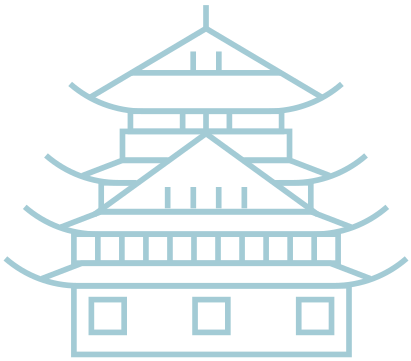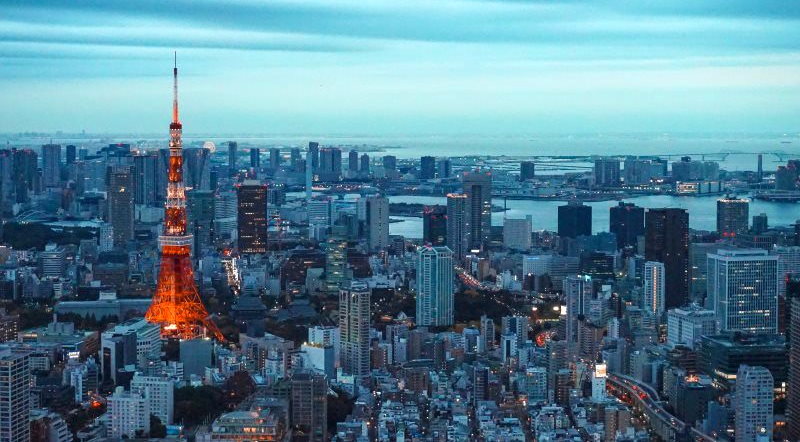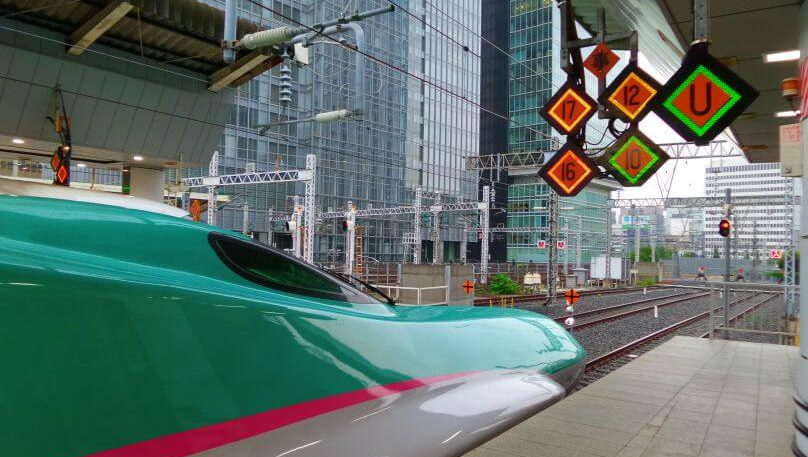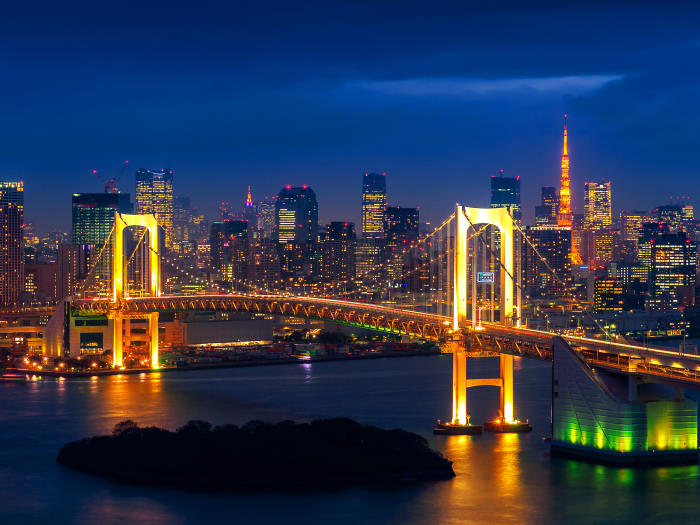Did you know?
The trademark of Tokyo is the cherry blossom. Every April, cherry blossom trees fill with little pink flowers, creating a magical scenery. This season is called Hanami in Japanese.
In this article
Do you know what’s fascinating about going on holiday to Tokyo?
It’s that Tokyo NEVER fails to surprise travelers -even the most demanding ones. This bustling metropolis -an enormous theme park- bursts with sky-piercing buildings, blinding lights, quirky shops of every kind, sumptuous hotels… the list goes on and on! What’s not to love about Tokyo?
However, the truth is that this city is vast and cram-full with people and buildings, so you need to know the basics before you go. No worries, we got you covered! Keep reading to find out EVERYTHING you need to know about planning a holiday to Tokyo.
Explore more: Tokyo things to do | Tokyo best hotels

Tokyo is a colorful metropolis that never sleeps -it’s always on the move! Just imagine a city full of imposing skyscrapers, jaw-dropping neon lights, innovative technology, and glowing lanterns. Fascinating, right? Add the super-famous Japanese tradition and art in the mix and you have one of the most interesting destinations in the world!
Keep reading to find out everything about this ever-changing capital, from the best places to stay in Tokyo and the best things to do, to the must-try foods in Tokyo, and the best ways to get around.

Tokyo is a magnificent city, full of surprises. It’s the biggest city in the world with nearly 38,000,000 residents and the largest commercial center in Japan, where everything is big and stunning. Full of towering skyscrapers, enormous screens, and shops that sell literally everything, this buzzing metropolis sure knows how to stand out! Fashion is also a big part of Tokyo’s identity. Wandering around the city, you’ll see women with kimonos, teenage girls with fancy school uniforms, and men that seem to have popped out of a fashion show. Tokyo is an absolute wonderland!
Tokyo lies at Tokyo Bay on the Pacific coast of central Honshu, the main island of Japan. The city belongs to the Kantō region.
Tokyo is amazing all year round! However, the best time of the year to visit Tokyo is in spring, during the cherry blossom season (March-April). Winter in Tokyo is mild yet chilly, while summer is steaming hot and humid.
Autumn (September to November)
Highest: 79 F/ 26 C Lowest: 48 F/ 9C
Winter (December to February)
Highest: 52 F/ 11 C Lowest: 36 F/ 2 C
Spring (March to May)
Highest: 70 F/ 21 C Lowest: 41 F/ 5 C
Summer (June to August)
Highest: 84 F/ 29 C Lowest: 64 F/ 18 C
The trademark of Tokyo is the cherry blossom. Every April, cherry blossom trees fill with little pink flowers, creating a magical scenery. This season is called Hanami in Japanese.
Tokyo has many Shinto shrines and Buddhist temples, which represent two different religions that have evolved in Japan! Some shrines and temples you need to visit are the Meiji Shrine, the Sensoji Temple, the Nezu Shrine, the Tennoji Temple, the Yushima Seido, Yushima Seido, and the Yasukuni Shrine.
Besides ordinary museums, like history and art museums, in Tokyo, you’ll also find museums about anime, parasites, instant ramen, samurais, criminal materials, and many more super interesting topics! Some museums you should visit are the Yayoi Kusama Museum, the Digital Art Museum, the Meguro Parasitological Museum, the Tokyo Photographic Art Museum, the Tobacco and Salt Museum, and the National Museum of Modern Art.
Asakusa is an area in downtown Tokyo that looks like a painting! Other than that, it is also full of amazing places for sightseeing, like the Sensoji Temple, the Nishi Sando Commercial Street, the Tokyo Skytree, and the Asakusa Shrine. Wandering Asakusa, you’ll feel transported to another era.
Tokyo seems to be made of skyscrapers, but don’t be fooled -it hides some beautiful green pieces of heaven! So, if you want to escape the summer heat or relax in nature, visit the Shinjuku Gyoen National Garden, the Imperial Palace East Garden, the Yoyogi Park, the Todoroki Valley, and the Kiyosumi Teien.
Related: 17 Best things to do in Tokyo: Attractions, Trendy Places & Tours you can’t miss
In general, shops in Tokyo are open from 10:00 to 20:00 throughout the week and on national holidays. Keep in mind that some local shops are closed on Wednesdays.
Population
37,393,128 (2020)
Currecy
Yen
Language
Japanese
Average Temperatures
Warmest Month: August (26°C/ 80°F)
Coldest Month: January (1°C/ 32°F)
Tipping
Tipping is not particularly common in Tokyo.
However, there is usually a service fee (10%-15%) at high-end restaurants, bars, and hotels.
Loved by
Art lovers, tech savvies, fashionistas, and science enthusiasts
Traces of Tokyo’s history are found back in the 3rd millennium BC, when it was just a fishing village in the Kantō Plain. However, the history of Tokyo originally started in the 12th century, when the military governor Edo Shigenaga decided to build his castle in the area. When Tokugawa Ieyasu established himself in Edo castle in 1590, one of the most important periods in the history of Japan (the Edo period) started.
Due to its distance from other countries (especially European), the best way to get to Tokyo is by air. However, if you’re planning to travel to Tokyo from another city in Japan, the train is a very good alternative!
Tokyo has two airports: Narita Airport and Haneda Airport. Narita Airport is the main international airport in Tokyo, as it mostly serves international flights and some domestic flights. Haneda Airport on the other side mainly serves domestic flights and some international flights. The duration of a flight to Japan is long. For example, a flight from the US to Japan lasts for 14 hours, so we don’t suggest booking an economy class ticket. It’s better to enjoy a comfortable trip! Some of the major airlines that fly directly to Tokyo are British Airways, Lufthansa, Emirates, SWISS, American Airlines, Air France, Delta Airlines, Air Canada, and Alitalia.
You can easily get to both airports in Tokyo by train. Narita airport lies a bit out of the town, but it can be easily accessed by the Narita Express train. As for the Haneda airport, it is located closer to the city center and it can be reached by train within half an hour.
You can get to Tokyo from other Japanese towns fast and easily by shinkansen (bullet train), a high-speed train that runs between Tokyo and several Japanese regions. One of the most popular train itineraries is the one from Osaka/Kyoto to Tokyo, which lasts for about three hours. There are also frequent train schedules from Kanazawa, Kyushu, and Niigata. If you get the chance, we highly recommend taking the train from Tokyo and explore other Japanese towns and regions!
Shinjuku is the best area to stay if you’re visiting Tokyo for the first time. Full of fancy buildings, neon lights, and skyscrapers, Shinjuku represents the culture of Tokyo. There are plenty of interesting places to visit in Shinjuku, like the Shinjuku Gyoen National Garden, the Yoyogi Park and Harajuku, and the Metropolitan Government Building. In Shinjuku, you’ll also find several affordable accommodation options as well as delicious restaurants!
Some of the best hotels in Shinjuku are: Park Hyatt Tokyo, Mitsui Garden Hotel Jingugaien Tokyo Premier, APA Hotel Shinjuku Kabukicho Chuo, Hyatt Regency Tokyo, and ONSEN RYOKAN YUEN SHINJUKU
Asakusa is a perfect place to stay in Tokyo if you have a tight budget. Located in the heart of Tokyo, Asakusa breaths tradition and culture. In this area, you’ll find Japanese temples, budget-friendly hotels, affordable restaurants, and shops. Some of the best things to see near Asakusa are the Sensoji Temple, the Tokyo Skytree, and Sumida Park.
Some of the best hotels in Asakusa are: Richmond Hotel Premier Asakusa International, Onyado Nono Asakusa Natural Hot Spring, The Gate Hotel Asakusa Kaminarimon by Hulic, Asakusa View Hotel, and Hotel Gracery Asakusa
If you want to enjoy the city’s nightlife, Roppongi is a one-way destination. Popular for its bars and clubs, Roppongi is one of the trendiest areas in Tokyo, especially for youngsters. Except for numerous nightlife options, in Roppongi, you’ll also find sushi bars, takoyaki restaurants, pizzerias, and Asian Kebab restaurants. There’s no way you won’t find the perfect place for you!
Some of the best hotels in Roppongi are: Mitsui Garden Hotel Roppongi Tokyo Premier, Candeo Hotels Tokyo Roppongi, MIMARU TOKYO AKASAKA, THE LIVELY AZABUJUBAN TOKYO, and remm Roppongi
The best place to stay in Tokyo for families is Odaiba. This area might be a bit far from the city center, but it is ideal for families with kids, as it offers plenty of kid-friendly activities and it is close to Tokyo Disney. In the area, you’ll also find many museums and theme parks. Kids will be thrilled!
Some of the best hotels in Odaiba are: Grand Nikko Tokyo Daiba, Sotetsu Grand Fresa Tokyo-Bay Ariake, Hilton Tokyo Odaiba, Daiwa Roynet Hotel Tokyo Ariake, and Hotel Trusty Tokyo Bayside
Related: Tokyo best hotels and places to stay
Tokyo is well-known for its excellent transportation network. Especially the metro and train networks are among the best ones in the world! Below, you’ll find the best ways to get around Tokyo using public transportation.

Metro is arguably the best way to get around Tokyo. Tokyo metro network comprises 13 lines and is run by Tokyo Metro (nine lines) and the Toei Subways (four lines) companies. Although the metro map seems complicated, it isn’t difficult to navigate. Tokyo metro network has many lines that cross the whole city, getting you from one side of Tokyo to the other in no time!
Our tip: To skip the hassle and save money, we suggest purchasing a Pasmo or Suica card instead of a one-day ticket. You can also get a Tokyo Combination Ticket, which is a one-day ticket for unlimited access to buses, metro, and trains.
Getting around Tokyo by train is a great option, as the train network is well-organized and efficient. Tokyo trains are managed by the Japanese Rail company and some private rail companies. The main trail line you need to know about is the JR Yamanote Line, also known as the Japan Rail Loop Line, which is a connection point for all metro lines and includes the most popular stations in Tokyo.
Buses are a good alternative for getting around the city center of Tokyo, especially in areas which the metro network doesn’t cover. The cost of a bus ticket in Tokyo is 210 yen for adults and 110 yen for children. However, it is better to get a Pasmo or Suica card for unlimited bus rides or a Tokyo Combination Ticket.
We don’t recommend getting around Tokyo by car, as the traffic is terrible. Besides, the metro, train, and buses will get you everywhere in and outside the town, so there is no need for a car.
The amount of money you’re going to spend in Tokyo per day depends mainly on your budget. If, for example, you have a tight budget, you can spend as little as 60-70$ per day, provided that you’ll stay in a hostel, get around by metro, and live on instant noodles. But, to enjoy your time in Tokyo, see all the points of interest, do fun activities, and taste all the local delicacies, you’ll need about 140$ (15,000 yen) per day.
Indicatively, a hotel room in Tokyo costs 50-60$, a dorm bed in a hostel costs 30-40$, and a private room on Airbnb 60-70$. As for food, you’re going to spend about 20$ on breakfast, 5-7$ on a bento box from a convenience store, and about 30$ for a meal at a budget-friendly restaurant.
Sushi is arguably the most popular food to eat in Tokyo! The best places to try this traditional Japanese specialty in Tokyo are the Tsukiji Outer Market (go early in the morning for sushi breakfast) and any of the conveyor-belt sushi (kaiten sushi) restaurants in Tokyo, where you’ll get to enjoy several sushi dishes without spending too much. However, if you can afford it, we highly recommend eating sushi at a Michelin-starred restaurant in Tokyo -it’s really worth it!
Tempura is a traditional Japanese dish made with meat, seafood (like shrimp) or vegetables (like sweet potato) covered with batter and deep-fried. There are many restaurants in Tokyo that specialize in different kinds of tempura, which is often served with a side of noodles or plain.
Ramen is a super-famous Japanese delicacy! This dish consists of noodles, pork, eggs, bamboo shoots, and nori sheets served in a delicious broth. In Tokyo, you’ll find many ramen restaurants, where you can try several types of ramen, like shio ramen, tonkatsu ramen, tsukemen, and miso ramen.
Yakitori, a popular street food delicacy in Japan, is grilled chicken skewers with soy sauce. Although yakitori is typically made with chicken, you can also find vegetable yakitori and pork yakitori. Although yakitori is typically a street food, you can also enjoy it at an izakaya (gastropub) and at restaurants that specialize in yakitori.
In Tokyo, there are two types of health insurance: private insurance (usually provided by employers) and public health insurance (provided by the government). Hospitals in Japan typically accept Japanese health insurances, but you can pay for any medical service and get the money you have paid back when you get back to your country. Except for large clinics and hospitals, there are also small doctor’s offices (naika), which you can find in most neighborhoods.
Tokyo is an overall safe country for tourists, although there are some unsafe places, as in every country. It is generally safe to walk around Tokyo, even late at night. Keep in mind though that there are some areas where you need to have some extra street sense. What’s more, tap water is safe to drink, but you have to be careful with some foods!
Summer in Tokyo is rainy and humid, so you need to pack accordingly! Make sure that you have with you an umbrella, a raincoat, a pair of comfortable sneakers for walking, a light jacket, t-shirts, some pairs of linen or cotton pants, and sundresses.
The temperature in Tokyo drops during the fall and there are also many rainfalls, so having an umbrella with you is highly recommended! If you’re planning to travel to Tokyo in fall, pack long-sleeve shirts, comfortable sneakers, some cardigans, and a warm coat.
Winter in Tokyo is dry and cold, so warm layers are the key. Some must-have garments to pack are wool cardigans, warm coats, scarfs, hoodies, long pants, and boots.
The weather is mild in Tokyo during spring, but keep in mind that it’s cool in early morning and at night. Some must-have clothes you need to pack are a light coat, t-shirts, light sweaters, thick pants, and tights (for women).
A handcrafted kitchen knife
A pair of split-toe socks
Red bean and fruit rice cakes
A folding fan
A summer kimono (yukata)
Chopsticks
A holiday to Tokyo is a fascinating experience. Not only thanks to the city’s high-tech charm and concrete masterpieces, but also because of its unparalleled natural beauty and enduring history. Tokyo is the absolute traditional-modern blend!
Have you ever been in Tokyo? If so, what are your tips for an unforgettable stay? Tell us in the comments and don’t miss sharing this article on Social Media if you liked it!
Other Travel Guides you may be interested in: Florence holidays travel guide | Venice holidays travel guide | Milan holidays travel guide | Rome holidays travel guide | Naples holidays travel guide | London holidays travel guide | Paris holidays travel guide | Amsterdam holidays travel guide

Your email address will not be published. Required fields are marked.*